
Small gully in Wise County.
Stream Erosion
Water flowing through a channel has the ability to transport sediment supplied to it from hillslopes and/or erode its banks and bed to produce sediment to transport. The amount of sediment transported depends mainly on the volume of flow; this is of course related to the size of the drainage basin and will fluctuate according to inputs of precipitation.
The volume of streamflow, or discharge, is measured in cubic meters (or feet) per second. A graph showing the fluctuation in discharge through time is a HYDROGRAPH.
Sediment Sources in Denton Creek Drainage Basin.
Denton Creek drains portions of Montague, Wise and Denton counties. Clastic sediment sources in the drainage basin include rills, gullies and channel bank and bed erosion. Sediment eroded from the drainage basin is deposited into Grapevine Lake.
The combination of heavy rain (for example during spring thunderstorms) and sandy ground with low permeability causes surface run-off and erosion in the northern portion of the drainage basin. The erosion creates large gullies and smaller rills.

Small gully in Wise County.
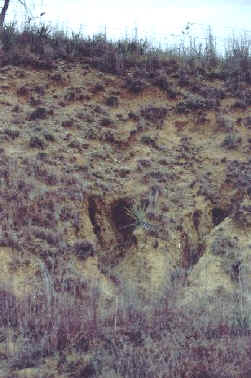
Rills in Wise County.
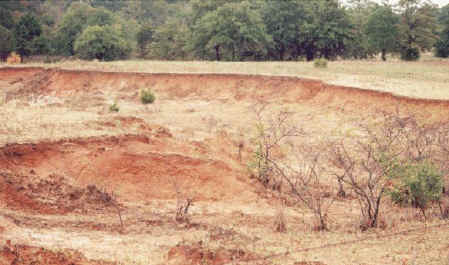
Large gully in Wise County.

Denton Creek bank and bed erosion in Wise County.
So, the visible sources are rills, gullies and bank/bed erosion - how is the sediment transported? Generally, 3 main sediment transport modes are recognized:

1. Solution load - dissolved rock carried in the flow; generally, this is higher where much of the flow is derived from groundwater pathways, which allow water to stay in contact with rock for long periods. It is also higher where local bedrock is prone to chemical weathering - e.g. the limestones in the southern portion of Denton Creek drainage basin (this sediment is in effect "invisible").
2. Suspended load - finer sediment (usually clay and silt) suspended by turbulence in the flow (does not contact bed).
3. Bed load - coarser sediment (sand + gravel) that slides, rolls or skips along the stream bed - amount depends on the tractive force exerted by the flow + resisting force of bed material.
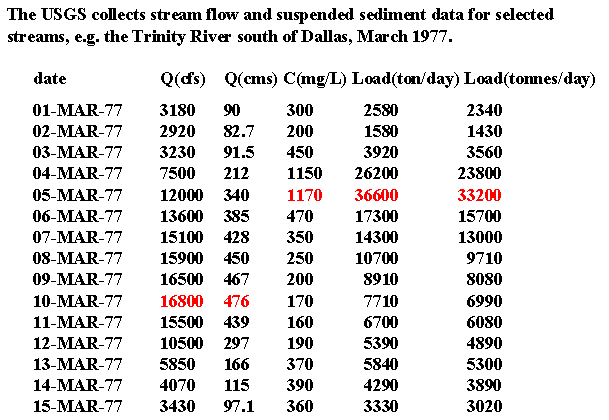

Notice the rising limb of the flow "flushes out" the readily available
suspended sediment.
Where does the sediment go? In the case of Denton Creek, some of it is deposited in the floodplain surrounding the creek, some is deposited on the bed of the creek and the rest ends up in Grapevine Lake.
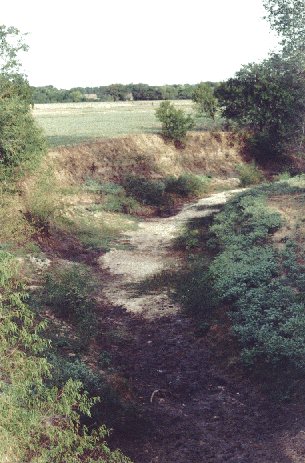
Channel and floodplain of Denton Creek.
How do we measure stream discharge (Q)? : the volume of water flowing through the creek can be calculated by multiplying the cross-sectional area of flow (A) by the mean flow velocity (V). The cross-sectional area of flow can be found by simply measuring the depth of the stream at regular intervals (e.g. 1 meter) across the channel. Mean flow velocity can be measured by a flow velocity meter. Usually a number of measurements are collected from different positions across the stream and then averaged to find the mean velocity.
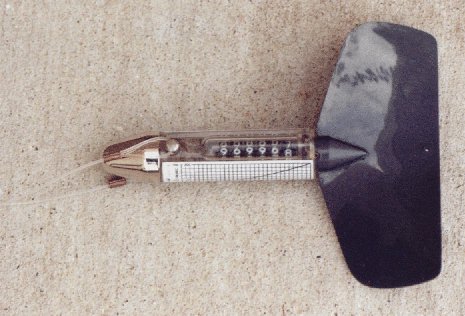
Flow Velocity Meter.
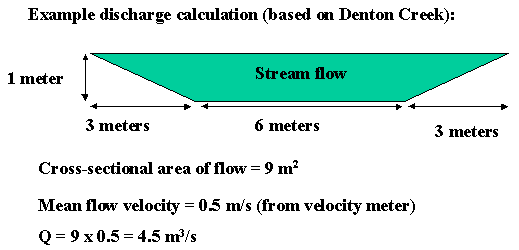
How do we measure suspended sediment load (Ss)?: the amount of sediment suspended in the flow can be calculated by filtering the sediment out of a water sample of known volume (e.g. 1 liter). Filtering devices usually employ a vacuum pump to draw the water sample through an extremely fine-mesh filter.
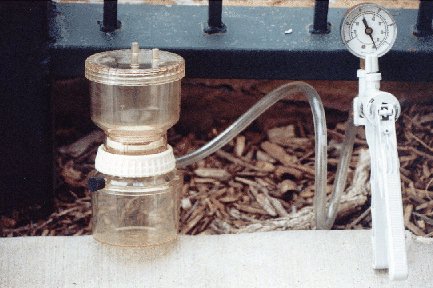
Suspended Sediment Filter and Vacuum Pump.
Example suspended sediment concentration and suspended sediment load calculation.
Volume of water filtered = 1 liter
Weight of dry sediment trapped on filter = 200 milligrams
Concentration = 200 mg/L (similar to Trinity River)
Suspended sediment load = 200 mg/L x 4.5 m3/s x 1,000 L/m3
= 900,000 mg/s
(multiply by seconds in a day) = 77,760,000,000 mg/day
(divide by mg in a tonne) = 77.76 tonnes/day
The Trinity River example has a typical suspended load of about 4000 tonnes/day, but it is a much bigger stream (typical flow about 200 m3/s).
How do we measure Bed Sediment Load (Sb)?: coarse sediment (sand, gravel) that remains in contact with the stream bed as it is transported downstream (bed load) can be estimated mathematically. One approach is based on estimating the bed shear stress (the force exerted on the stream bed sediment by the flowing water) and the critical shear stress (the amount of force required to move stream bed sediment).
How do we know that bed load is being transported? The tractive force exerted on the bed by stream flow deforms the bed into various sedimentary structures such as ripples and dunes - if these are visible, it suggests that bed load transport is occurring.
Example Questions:
1. Describe the major clastic sediment sources in Denton Creek drainage basin.
2. Describe the 3 modes of sediment transport by streams.
3. Based on the examples from Denton Creek shown in class, describe how to measure discharge and suspended sediment load.